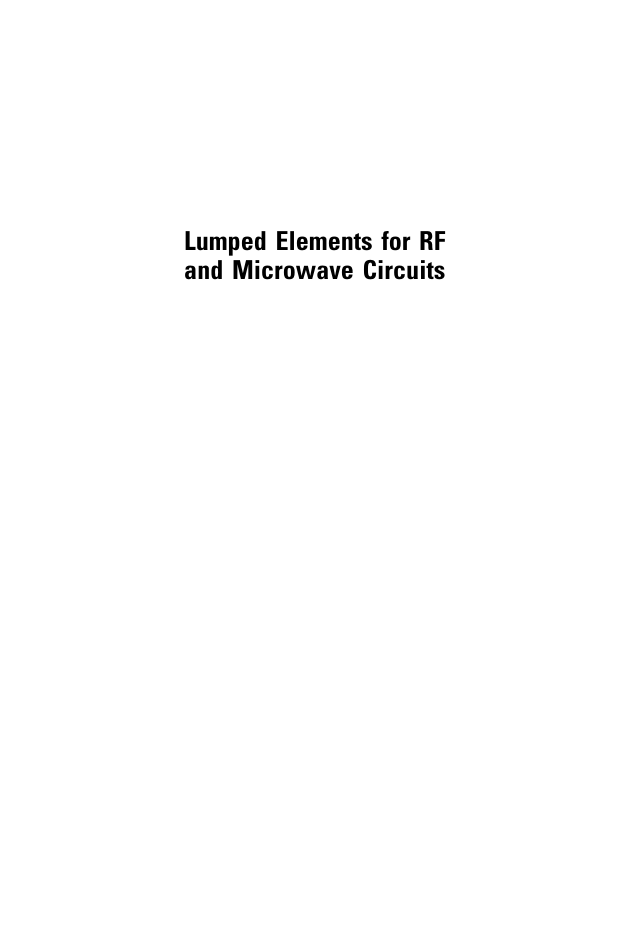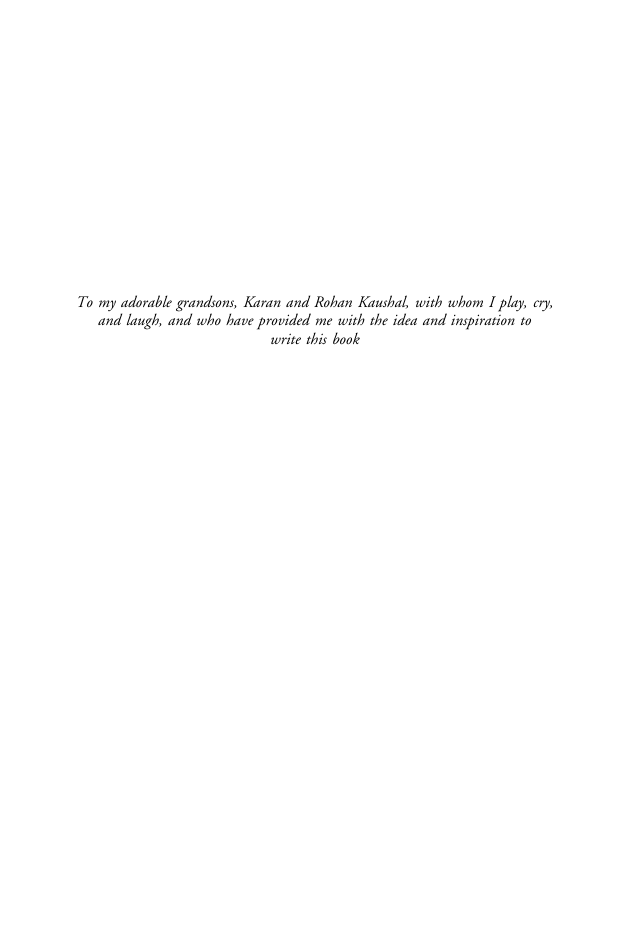Lumped Elements for RF
and Microwave Circuits
Lumped Elements for RF
and Microwave Circuits
Copyright
Contents
Preface
Acknowledgments
1 Introduction
1.1 History of Lumped Elements
1.2 Why Use Lumped Elements for RF and Microwave Circuits?
1.3 L, C, R Circuit Elements
1.4 Basic Design of Lumped Elements
1.4.1 Capacitor
1.4.2 Inductor
1.4.3 Resistor
1.5 Lumped- Element Modeling
1.6 Fabrication
1.7 Applications
References
2 Inductors
2.1 Introduction
2.2 Basic Definitions
2.2.1 Inductance
2.2.2 Magnetic Energy
2.2.3 Mutual Inductance
2.2.4 Effective Inductance
2.2.5 Impedance
2.2.6 Time Constant
2.2.7 Quality Factor
2.2.8 Self- Resonant Frequency
2.2.9 Maximum Current Rating
2.2.10 Maximum Power Rating
2.2.11 Other Parameters
2.3 Inductor Configurations
2.4 Inductor Models
2.4.1 Analytical Models
2.4.2 Coupled- Line Approach
2.4.3 Mutual Inductance Approach
2.4.4 Numerical Approach
2.4.5 Measurement- Based Model
2.5 Coupling Between Inductors
2.5.1 Low- Resistivity Substrates
2.5.2 High- Resistivity Substrates
2.6 Electrical Representations
2.6.1 Series and Parallel Representations
2.6.2 Network Representations
References
3 Printed Inductors
3.1 Inductors on Si Substrate
3.1.1 Conductor Loss
3.1.2 Substrate Loss
3.1.3 Layout Considerations
3.1.4 Inductor Model
3.1.5 Q- Enhancement Techniques
3.1.6 Stacked- Coil Inductor
3.1.7 Temperature Dependence
3.2 Inductors on GaAs Substrate
3.2.1 Inductor Models
3.2.2 Figure of Merit
3.2.3 Comprehensive Inductor Data
3.2.4 Q- Enhancement Techniques
3.2.5 Compact Inductors
3.2.6 High Current Handling Capability Inductors
3.3 Printed Circuit Board Inductors
3.4 Hybrid Integrated Circuit Inductors
3.4.1 Thin- Film Inductors
3.4.2 Thick- Film Inductors
3.4.3 LTCC Inductors
3.5 Ferromagnetic Inductors
References
4 Wire Inductors
4.1 Wire- Wound Inductors
4.1.1 Analytical Expressions
4.1.2 Compact High- Frequency Inductors
4.2 Bond Wire Inductor
4.2.1 Single and Multiple Wires
4.2.2 Wire Near a Corner
4.2.3 Wire on a Substrate Backed by a Ground Plane
4.2.4 Wire Above a Substrate Backed by a Ground Plane
4.2.5 Curved Wire Connecting Substrates
4.2.6 Twisted Wire
4.2.7 Maximum Current Handling of Wires
4.3 Wire Models
4.3.1 Numerical Methods for Bond Wires
4.3.2 Measurement- Based Model for Air Core Inductors
4.3.3 Measurement- Based Model for Bond Wires
4.4 Magnetic Materials
References
5 Capacitors
5.1 Introduction
5.2 Capacitor Parameters
5.2.1 Capacitor Value
5.2.2 Effective Capacitance
5.2.3 Tolerances
5.2.4 Temperature Coefficient
5.2.5 Quality Factor
5.2.6 Equivalent Series Resistance
5.2.7 Series and Parallel Resonances
5.2.8 Dissipation Factor or Loss Tangent
5.2.9 Time Constant
5.2.10 Rated Voltage
5.2.11 Rated Current
5.3 Chip Capacitor Types
5.3.1 Multilayer Dielectric Capacitor
5.3.2 Multiplate Capacitor
5.4 Discrete Parallel Plate Capacitor Analysis
5.4.1 Vertically Mounted Series Capacitor
5.4.2 Flat- Mounted Series Capacitor
5.4.3 Flat- Mounted Shunt Capacitor
5.4.4 Measurement- Based Model
5.5 Voltage and Current Ratings
5.5.1 Maximum Voltage Rating
5.5.2 Maximum RF Current Rating
5.5.3 Maximum Power Dissipation
5.6 Capacitor Electrical Representation
5.6.1 Series and Shunt Connections
5.6.2 Network Representations
References
6 Monolithic Capacitors
6.1 MIM Capacitor Models
6.1.1 Simple Lumped Equivalent Circuit
6.1.2 Coupled Microstrip- Based Distributed Model
6.1.3 Single Microstrip- Based Distributed Model
6.1.4 EC Model for MIM Capacitor on Si
6.1.5 EM Simulations
6.2 High- Density Capacitors
6.2.1 Multilayer Capacitors
6.2.2 Ultra- Thin- Film Capacitors
6.2.3 High- K Capacitors
6.2.4 Fractal Capacitors
6.2.5 Ferroelectric Capacitors
6.3 Capacitor Shapes
6.3.1 Rectangular Capacitors
6.3.2 Circular Capacitors
6.3.3 Octagonal Capacitors
6.4 Design Considerations
6.4.1 Q- Enhancement Techniques
6.4.2 Tunable Capacitor
6.4.3 Maximum Power Handling
References
7 Interdigital Capacitors
7.1 Interdigital Capacitor Models
7.1.1 Approximate Analysis
7.1.2 J- Inverter Network Equivalent Representation
7.1.3 Full- Wave Analysis
7.1.4 Measurement- Based Model
7.2 Design Considerations
7.2.1 Compact Size
7.2.2 Multilayer Capacitor
7.2.3 Q- Enhancement Techniques
7.2.4 Voltage Tunable Capacitor
7.2.5 High- Voltage Operation
7.3 Interdigital Structure as a Photodetector
References
8 Resistors
8.1 Introduction
8.2 Basic Definitions
8.2.1 Power Rating
8.2.2 Temperature Coefficient
8.2.3 Resistor Tolerances
8.2.4 Maximum Working Voltage
8.2.5 Maximum Frequency of Operation
8.2.6 Stability
8.2.7 Noise
8.2.8 Maximum Current Rating
8.3 Resistor Types
8.3.1 Chip Resistors
8.3.2 MCM Resistors
8.3.3 Monolithic Resistors
8.4 High- Power Resistors
8.5 Resistor Models
8.5.1 EC Model
8.5.2 Distributed Model
8.5.3 Meander Line Resistor
8.6 Resistor Representations
8.6.1 Network Representations
8.6.2 Electrical Representations
8.7 Effective Conductivity
8.8 Thermistors
References
9 Via Holes
9.1 Types of Via Holes
9.1.1 Via Hole Connection
9.1.2 Via Hole Ground
9.2 Via Hole Models
9.2.1 Analytical Expression
9.2.2 Quasistatic Method
9.2.3 Parallel Plate Waveguide Model
9.2.4 Method of Moments
9.2.5 Measurement- Based Model
9.3 Via Fence
9.3.1 Coupling Between Via Holes
9.3.2 Radiation from Via Ground Plug
9.4 Plated Heat Sink Via
9.5 Via Hole Layout
References
10 Airbridges and Dielectric Crossovers
10.1 Airbridge and Crossover
10.2 Analysis Techniques
10.2.1 Quasistatic Method
10.2.2 Full- Wave Analysis
10.3 Models
10.3.1 Analytical Model
10.3.2 Measurement- Based Model
References
11 Transformers and Baluns
11.1 Basic Theory
11.1.1 Parameters Definition
11.1.2 Analysis of Transformers
11.1.3 Ideal Transformers
11.1.4 Equivalent Circuit Representation
11.1.5 Equivalent Circuit of a Practical Transformer
11.1.6 Wideband Impedance Matching Transformers
11.1.7 Types of Transformers
11.2 Wire- Wrapped Transformers
11.2.1 Tapped Coil Transformers
11.2.2 Bond Wire Transformer
11.3 Transmission- Line Transformers
11.4 Ferrite Transformers
11.5 Parallel Conductor Winding Transformers on Si Substrate
11.6 Spiral Transformers on GaAs Substrate
11.6.1 Triformer Balun
11.6.2 Planar- Transformer Balun
References
12 Lumped-Element Circuits
12.1 Passive Circuits
12.1.1 Filters
12.1.2 Hybrids and Couplers
12.1.3 Power Dividers/ Combiners
12.1.4 Matching Networks
12.1.5 Lumped- Element Biasing Circuit
12.2 Control Circuits
12.2.1 Switches
12.2.2 Phase Shifters
12.2.3 Digital Attenuator
References
13 Fabrication Technologies
13.1 Introduction
13.1.1 Materials
13.1.2 Mask Layouts
13.1.3 Mask Fabrication
13.2 Printed Circuit Boards
13.2.1 PCB Fabrication
13.2.2 PCB Inductors
13.3 Microwave Printed Circuits
13.3.1 MPC Fabrication
13.3.2 MPC Applications
13.4 Hybrid Integrated Circuits
13.4.1 Thin- Film MICs
13.4.2 Thick- Film Technology
13.4.3 Cofired Ceramic and Glass- Ceramic Technology
13.5 GaAs MICs
13.5.1 MMIC Fabrication
13.5.2 MMIC Example
13.6 CMOS Fabrication
13.7 Micromachining Fabrication
References
14 Microstrip Overview
14.1 Design Equations
14.1.1 Characteristic Impedance and Effective Dielectric Constant
14.1.2 Effect of Strip Thickness
14.2 Design Considerations
14.2.1 Effect of Dispersion
14.2.2 Microstrip Losses
14.2.3 Quality Factor Q
14.2.4 Enclosure Effect
14.2.5 Frequency Range of Operation
14.2.6 Power- Handling Capability
14.3 Coupled Microstrip Lines
14.3.1 Even- Mode Capacitance
14.3.2 Odd- Mode Capacitance
14.3.3 Characteristic Impedances
14.3.4 Effective Dielectric Constants
14.4 Microstrip Discontinuities
14.5 Compensated Microstrip Discontinuities
14.5.1 Step- in- Width
14.5.2 Chamfered Bend
14.5.3 T- Junction
References
Appendix
About the Author
Index
















 2023年江西萍乡中考道德与法治真题及答案.doc
2023年江西萍乡中考道德与法治真题及答案.doc 2012年重庆南川中考生物真题及答案.doc
2012年重庆南川中考生物真题及答案.doc 2013年江西师范大学地理学综合及文艺理论基础考研真题.doc
2013年江西师范大学地理学综合及文艺理论基础考研真题.doc 2020年四川甘孜小升初语文真题及答案I卷.doc
2020年四川甘孜小升初语文真题及答案I卷.doc 2020年注册岩土工程师专业基础考试真题及答案.doc
2020年注册岩土工程师专业基础考试真题及答案.doc 2023-2024学年福建省厦门市九年级上学期数学月考试题及答案.doc
2023-2024学年福建省厦门市九年级上学期数学月考试题及答案.doc 2021-2022学年辽宁省沈阳市大东区九年级上学期语文期末试题及答案.doc
2021-2022学年辽宁省沈阳市大东区九年级上学期语文期末试题及答案.doc 2022-2023学年北京东城区初三第一学期物理期末试卷及答案.doc
2022-2023学年北京东城区初三第一学期物理期末试卷及答案.doc 2018上半年江西教师资格初中地理学科知识与教学能力真题及答案.doc
2018上半年江西教师资格初中地理学科知识与教学能力真题及答案.doc 2012年河北国家公务员申论考试真题及答案-省级.doc
2012年河北国家公务员申论考试真题及答案-省级.doc 2020-2021学年江苏省扬州市江都区邵樊片九年级上学期数学第一次质量检测试题及答案.doc
2020-2021学年江苏省扬州市江都区邵樊片九年级上学期数学第一次质量检测试题及答案.doc 2022下半年黑龙江教师资格证中学综合素质真题及答案.doc
2022下半年黑龙江教师资格证中学综合素质真题及答案.doc